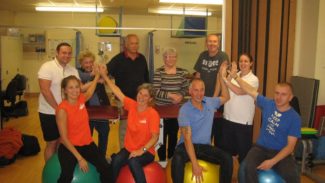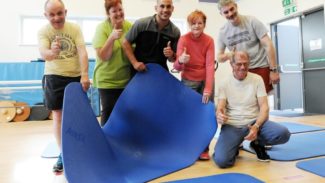
Physiotherapy
Discover the important role physiotherapy plays in managing your axial SpA
Read moreTips to help you exercise safely
This information is for anyone with axial spondyloarthritis, including people with ankylosing spondylitis
Remember to seek medical advice if you become faint, short of breath, dizzy, unwell or experience unaccustomed chest pain during an exercise session.
Some exercise instructors may not have heard of axial SpA and may not understand how it affects you. Take time to explain your condition. You can download our Information for exercise instructors and give it to staff.
Don’t overdo it. Keep within your limits, especially when you first start.
You will have good and bad days where can do a bit more or may need to do a little bit less.
Pick a good time of day to exercise – many people with axial SpA experience some pain and stiffness in the mornings, so you may prefer to exercise later in the day.
Don’t worry if you have some mild aches and pains when you are exercising. This is normal. The aching should ease off after your exercise session is over. If you have more than mild aches and pains after exercising seek medical advice.
If you use weights – use a regime involving low weights and high repetitions. Remember you are trying to stay mobile, strong and healthy.
Maintain a good posture during all of your exercises. The mirror is your friend.
Vary your exercises. Remember you need a mix of strengthening, cardiovascular and stretching exercises.
Having axial SpA can put you are at greater risk of having thinner bones (osteoporosis). During contact sports you may experience hard knocks and blows that may cause a bone to break.
Some people with axial SpA may also have stiffening or fusion of the spine. This means that you may be at risk of breaking one of the bones in your spine (your vertebrae) during contact sports.
If you enjoy taking part in contact sports then do discuss it with your physiotherapist and get their advice.
High impact sports involve pounding actions, including running, which can cause extra stress on the joints of the legs and the spine. This in turn can lead some people with axial SpA to experience a flare.
If you currently enjoy high impact exercise monitor your symptoms and be open to modifications if it causes a flare. It is possible that your body’s tolerance to high impact exercise changes over time and you find that some exercises cause you pain when this never used to be the case.
If you are considering high impact exercise for the first time do seek advice from your physiotherapist.
Many people prefer to avoid high impact sports during a flare.

Discover the important role physiotherapy plays in managing your axial SpA
Read more
Exercise in a friendly and supportive environment with NASS
Read more
Choosing an exercise class to suit your needs
Read more